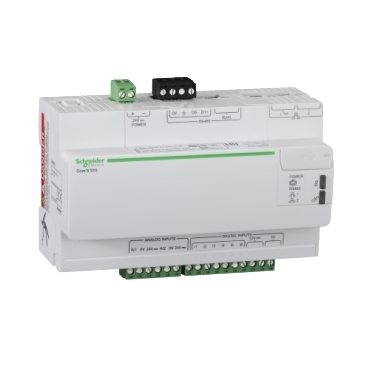The Com’X 510 by Schneider Electric is a versatile device that offers several advantages for energy management and monitoring. However, like any technology, it also has certain disadvantages that are worth considering. Here are some potential drawbacks of the Com’X 510:
Limited Compatibility: While the Com’X 510 supports various communication protocols, it may not be compatible with all types and models of electrical meters, sensors, or devices. Some devices may require additional adapters or converters to connect to the Com’X 510, which can add complexity and cost to the installation process.
Device Limitations: The Com’X 510 has its own limitations in terms of data storage capacity and processing power. Depending on the application and the volume of data being collected, the device may have constraints on the number of devices it can handle or the frequency of data updates it can support. In high-density monitoring scenarios or large-scale installations, additional Com’X 510 units may be required, which can increase the overall cost.
Initial Setup and Configuration: Setting up the Com’X 510 and configuring it to communicate with various devices can be complex, particularly for users who are not familiar with the device or the specific protocols involved. Proper knowledge and expertise may be required to ensure seamless integration and avoid compatibility issues.
Reliance on Network Connectivity: The Com’X 510 relies on network connectivity for data transmission and remote monitoring. In cases where the network infrastructure is unreliable or experiences downtime, there may be interruptions in data collection and transmission. This can impact the real-time monitoring capabilities and delay the availability of critical information.
Security Considerations: Like any network-connected device, the Com’X 510 introduces potential security risks. If not properly secured, it may be vulnerable to unauthorized access, data breaches, or cyber attacks. It is important to implement robust security measures, including firewalls, encryption, and access controls, to protect the device and the data it collects.
Maintenance and Support: While the Com’X 510 is designed for reliable operation, like any electronic device, it may require periodic maintenance or firmware updates. Depending on the availability of technical support and resources, obtaining assistance or troubleshooting issues may pose challenges, especially for users who are not familiar with the device or energy management systems.
Scalability: The scalability of the Com’X 510 may be a consideration for larger installations or expanding monitoring requirements. As the number of connected devices and data points increases, it may be necessary to evaluate the scalability of the system to ensure it can handle the growing data volume and meet future needs.
Cost: The Com’X 510 is an additional investment in an energy management infrastructure. The cost of the device, along with installation, integration, and potential customization, should be taken into account when evaluating the overall cost-effectiveness of deploying the device. It is essential to weigh the benefits it provides against the associated costs to determine its value for a specific application.
It is important to note that the disadvantages mentioned above are not necessarily applicable to every scenario or user. The significance of these drawbacks may vary based on individual requirements, existing infrastructure, and the level of expertise available for installation, configuration, and maintenance. Evaluating these disadvantages in the context of specific needs and constraints is crucial to make an informed decision about the implementation of the Com’X 510 device.











